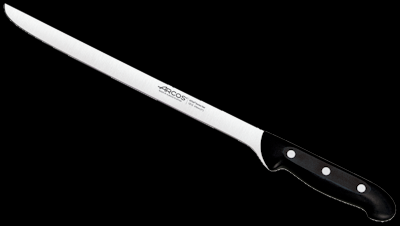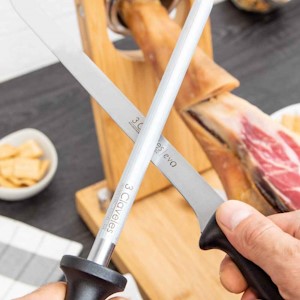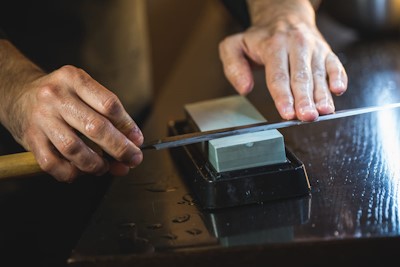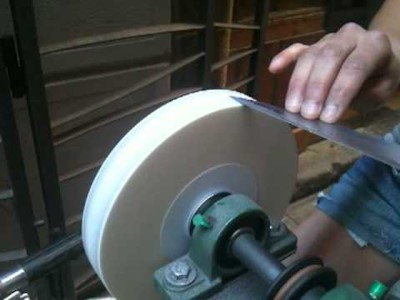Ham knives are a fundamental part of gastronomy, especially in cultures where ham is a culinary treasure. These tools, with their characteristic sharp blades and ergonomic designs, are essential for slicing ham into thin, delicious slices. However, to maintain their efficiency and ensure precise cuts, it is crucial to know how to keep them sharp. In this article, we will explore ham knives in depth, their characteristics, their importance in the kitchen and the best methods to keep them in optimal condition.
Characteristics of the Ham Knives

Ham knives are specifically designed to facilitate the ham slicing process, ensuring that each slice is made with the utmost delicacy and precision. Some of their most notable features include:
- Elongated, thin blade: The shape of the ham knife allows the slicer to maintain optimum control when sliding the blade along the ham, thus obtaining thin, uniform slices.
- Sharp edge: The extremely sharp edge of the ham knife allows for precise cuts, minimising the loss of flavour and texture of the ham.
- Flexibility: The flexibility of the blade allows it to adapt to the shape of the ham, making it easy to cut at the right angles to obtain the best slices.
- Ergonomic design: The ham knives are designed so that the cutter can use them comfortably for long periods without fatigue.
A knife with these specific characteristics is very necessary for you to really enjoy the hams that we offer in the Jamón Pasión Spanish ham store.
Importance of keeping the Ham Knife sharp
Keeping ham knives sharp is essential to ensure accurate and safe cuts. A dull knife can cause tears in the ham, affect the presentation of the ham, cause the meat not to express its full potential and consequently diminish the culinary experience. In addition, a dull knife can increase the risk of accidents during the cutting process.
Methods for keeping ham knives sharp

When you buy a ham knife, it is already perfectly sharpened and all you need to do is to keep its edge using the sharpening steel, a tool that consists of a steel bar with a handle. Always before cutting the ham leg, even after use, I recommend that you pass it through the sharpening steel again. If you follow this suggestion, the edge of the knife will remain in very good condition for a long time.
You must be clear that the function of the sharpening steel is to maintain the sharpness, that is to say, if a knife is dull, you will not be able to sharpen it by this process.
To sharpen a worn ham knife, there are several methods which, if you are not experienced in handling it, can damage the blade of the knife.
Manual sharpening with a stone

A traditional and effective technique for sharpening ham knives is to use sharpening stones. These stones come in different thicknesses and grits. Starting with a coarse stone and progressing to a finer one, a sharp and long-lasting edge can be obtained.
This technique is most commonly used professionally and can be carried out using portable stones that you can easily store in a drawer at home.
The technique consists of leaving the stone fixed and sliding the blade of the ham knife at an inclination of about 15º with respect to the stone. You will have to pass through one side repeatedly, and then through the other side. It has two sides, one with a coarser grain and the other finer, to finish the job and ensure that there is no roughness on the blade of the ham knife.
With this technique for sharpening knives at home, with a little practice, you will get very good results.
Electric sharpening with stone

The essence of this knife sharpener is the same as with the manual stone. The difference is that the stone is a thick disc that rotates on a lathe, so this time you don't have to slide the blade over the stone, but the stone slides over the blade.
The angle of inclination is the same, but we must be much more careful, as the stone, rotating at high speed, can wear the blade of the knife very easily. More experience is required to get a good sharpening of the ham knife with this electric version.
Other sharpeners
There are other techniques that are less used, mainly because they do not have the same control as with a sharpening stone, whether manual or electric, as they consist of introducing the blade of the knife into a device that can also be manual or electric, so we lose sight of the sharpness of the ham knife, as it is hidden inside the grooves of these devices.
Tips for the Care and Maintenance of the Ham Knife
Beyond sharpening, regular care and maintenance are essential to prolong the life of ham knives. Some important tips include:
- Proper Cleaning: After each use, it is crucial to wash and dry the knife thoroughly to avoid residue build-up and blade rust.
- Proper storage: Store ham knives in protective sheaths or a knife block to prevent damage and keep them out of the reach of children.
- Avoid dishwashers: It is preferable to wash ham knives by hand, as the dishwasher can damage the blade and handle over time.
- Proper use: Use ham knives only for cutting ham and related foods, such as sausages, avoiding hard or frozen surfaces that may damage the blade.
Ham knives are a real jewel in the gourmet kitchen, allowing you to cut Spanish ham with the delicacy and precision necessary to appreciate its unparalleled flavour and aroma. Keeping these knives sharp and well cared for is essential to preserve their efficiency and to enjoy their use for many years. With the knowledge of their characteristics and the proper methods for sharpening and maintaining them, any lover of Iberico ham will be able to experience the satisfaction of making perfect cuts in each slice.
